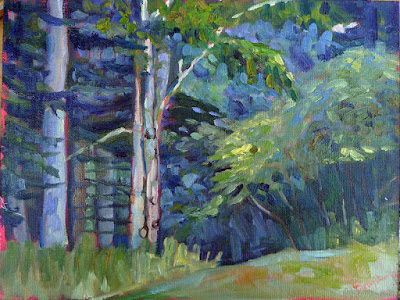You can learn a lot from videos, but the boring parts are edited out. It’s good to see our dithering.
 |
| It’s all about that green, by Carol L. Douglas. |
The weather service was spot on yesterday. It dawned cold and drizzling. We wrapped our southerners in blankets and took shelter under the Schoodic Institute picnic pavilion. Every plein air painter has a few of these protected places tucked into the back of her mind.
Usually I like to schedule the rain on my third or fourth day, so my students have a chance to get down onto the shore and collect detritus to make a still life. This hadn’t happened.
I tend to avoid full demos, instead demonstrating one key process each day during lunch. That’s more about my own hyperactivity than anything else. I never could sit through an all-day demo. Still, you can’t take away people’s processes and not give them a viable option in exchange.
 |
| My happy painting crew. |
It’s hard to paint from under that picnic pavilion. Traveling around the compass from the north, there is a restroom and a trash can, a chain link fence, a helicopter landing pad, and the mown edge of a woods. I find the restroom the most visually interesting, but settled on a gash in the woods where a service road cuts down to the park’s volunteer housing.
I started with developing an idea, and how I built it from what I saw. I did a sketch, a value study in watercolor and then slowly developed a painting through all its constituent steps, focusing on how to move from thin layers to fat layers at the top.
Oil paints dry at different speeds depending on the pigment. However, the more oil in the paint, the longer it takes to oxidize, and the more flexible the paint film is. That’s great on top layers, where you want an oily binder to prevent “sinking,” where the oils in the top layer settle into lower layers. It’s not so good in the lower levels, where flexibility means instability. Ignoring this practice can result in cracked, less durable, paintings.
 |
| By mid-afternoon, the skies were clearing. Photo courtesy of Jennifer Johnson. |
Knowing that is one thing, but it’s kind of like making pie crust. Until you’ve seen it done, you don’t know what kind of consistence you’re really looking for. The best way to understand is to stick your finger in the paint, which I invited my students to do.
You can learn a lot from videos, but the boring parts are edited out. It’s good for students to see how many times we dither and change our minds.
Often in peninsular Maine, the weather can be very different in two nearby places. We drove to Frazer Point feeling hopeful. Sadly, it was still dripping. The parking lot was empty. Should we wait it out?
 |
| By evening, it was beautifully clear again. |
As we talked, the wind shifted. The rain stopped and suddenly the visitors were back in swarms. It was fabulous painting, and some of us stayed almost until the dinner bell rang at six.
I went back to my room and took a hot bath to scrub the paint off. Many of my students went to a talk on bats. “Why didn’t they just drive?” asked my husband. It took me a minute, but then I laughed.





